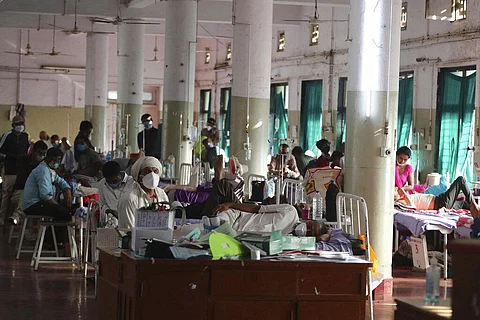Cow dung, stubble burning likely cause of black fungus during pandemic: Study
NEW DELHI: The spurt in fungal infections during Covid-19 in India may have been due to fumes generated from the burning of Mucorales-rich biomass like cow dung and cow stubble, a study in mBio, a journal published by the American Society of Microbiology, has claimed.
The report, authored by Jessy Skaria, Terry M John, Shiby Varkey and Dimitrios Kontoyiannis, claimed that mucormycosis (CAM) cases were attributed to the large number of diabetes mellitus (DM) among Indians and the use of steroids in the Covid-19 treatment.
But, it was noticed that fungus infection was not as significant in the west as in India despite the prevalence of diabetes and the use of corticosteroids in the Covid management.
Even without Covid, India has large cases of fungal infections but the spurt within the short span of the pandemic had raised eyebrows. The number of cases, according to the report, increased sharply in late April 2021 during the second wave. It increased to 41,000 in May before coming down in August to reach the pre-pandemic average.
The article said, "This raises the question of whether excessive environmental exposure to Mucorales spores is the unacknowledged factor in India’s CAM epidemic. One recent multicenter study from India showed that the Mucorales burden in the outdoor hospital environments in India is as high as 51.8 percent. Herein, we posit that important but overlooked cultural, religious, and social factors specific to India might be responsible for the excessive burden of fungal spores, including Mucorales spores, in the Indian environment."
The article talked about the cultural practices in India where the population is exposed to cow dung and fumes through the burning of Mucorales-rich biomass.
"Cow excrement is rich in Mucorales, which are coprophilous (dung-loving) fungi, with a particular affinity for herbivore dung. Twenty-four different taxa of Mucorales, including Mucor, Rhizopus, and Cunninghamella, have been identified in herbivore dung. India, with more than 300 million cattle, ranks highest in the global cattle inventory," said the article.
"Many Indians consume products that contain cow excreta; for example, Panchagavya, which is ingested as Ayurvedic medicine, contains milk, ghee, and curd but also cow dung and urine. In addition, common rituals in parts of India, include applying cow dung on bodies, drinking cow urine, and burning and inhaling cow-dung fumes as a form of ritual purification during festivals, prayers, or cremations," the article, published March 31, said.
It claimed that those exposed to such practices are likely to have their nasal passages more densely colonized by Mucorales spores increasing the chances of at-risk hosts developing mucormycosis.

